Related Research Articles

Okinawa Prefecture is a prefecture of Japan. Okinawa Prefecture is the southernmost and westernmost prefecture of Japan and has a population of 1,457,162 and a geographic area of 2,281 km2.

Ginowan is a city located in Okinawa Prefecture, Japan. As of 2012, the city has an estimated population of 94,405, with 40,041 households and a population density of 4,838.8 persons per km2. The total area is 19.51 km2.

United States Forces Japan (USFJ) is a subordinate unified command of the United States Indo-Pacific Command. It was activated at Fuchū Air Station in Tokyo, Japan, on 1 July 1957 to replace the Far East Command. USFJ is headquartered at Yokota Air Base in Tokyo and is commanded by the Commander, US Forces Japan who is also commander of the Fifth Air Force.
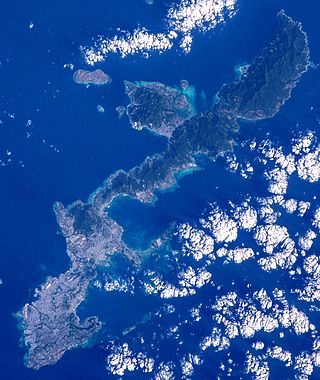
Okinawa Island, officially Okinawa Main Island, is the largest of the Okinawa Islands and the Ryukyu (Nansei) Islands of Japan in the Kyushu region. It is the smallest and least populated of the five main islands of Japan. The island is approximately 106 kilometres (66 mi) long, an average 11 kilometres (7 mi) wide, and has an area of 1,206.98 square kilometers (466.02 sq mi). It is roughly 640 kilometres south of the main island of Kyushu and the rest of Japan. It is 500 km northeast of Taiwan. The total population of Okinawa Island is 1,384,762. The Greater Naha area has roughly 800,000 residents, while the city itself has about 320,000 people. Naha is the seat of Okinawa Prefecture on the southwestern part of Okinawa Island. Okinawa has a humid subtropical climate.

Marine Corps Air Station Iwakuni or MCAS Iwakuni is a United States Marine Corps air station located in the Nishiki river delta, 1.3 NM southeast of Iwakuni Station in the city of Iwakuni, Yamaguchi Prefecture, Japan.

Marine Corps Air Station Futenma or MCAS Futenma is a United States Marine Corps base located in Ginowan, Okinawa, Japan, 5 NM northeast of Naha, on the island of Okinawa. It is home to approximately 3,000 Marines of the 1st Marine Aircraft Wing and other units, and has been a U.S. military airbase since the defeat of the Japanese Imperial Army in the Battle of Okinawa in 1945. Marine Corps pilots and aircrew are assigned to the base for training and providing air support to other land and sea-based Marines in Okinawa and throughout the Asia-Pacific region. MCAS Futenma is part of the Marine Corps Installations Pacific command.

Camp Schwab is a United States Marine Corps camp located in northeastern Okinawa Prefecture, Japan, that is currently home to the 4th Marine Regiment and other elements of the 28,000 American servicemen based on the island. The Camp was dedicated in 1959 in honor of Medal of Honor recipient Albert E. Schwab who was killed in action during the Battle of Okinawa.
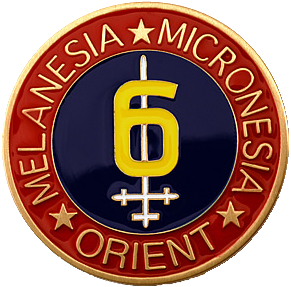
The 6th Marine Division was a United States Marine Corps World War II infantry division formed in September 1944. During the invasion of Okinawa it saw combat at Yae-Take and Sugar Loaf Hill and was awarded a Presidential Unit Citation. The 6th Division had also prepared for the invasion of Japan before the war ended. After the war it served in Tsingtao, China, where the division was disbanded on April 1, 1946, being the only Marine division to be formed and disbanded overseas and never set foot in the United States.

Camp Foster, formerly known as Camp Zukeran, is a United States Marine Corps camp located in Ginowan City with portions overlapping into Okinawa City, Chatan town and Kitanakagusuku village in the Japanese prefecture of Okinawa Island. It is part of the Marine Corps Base Camp Smedley D. Butler complex.

Camp Courtney is a U.S. Marine Base located in Uruma City, Okinawa Prefecture, Japan. It is part of the larger Marine Corps Base Camp Smedley D. Butler and home to the III Marine Expeditionary Force, 3rd Marine Division, and 3d MEB Headquarters. It is named after Major Henry A. Courtney, Jr., who was killed in action in the Battle of Okinawa. Camp Courtney covers 1.339 square kilometres (0.517 sq mi) in the Konbu, Tengan, and Uken districts of Uruma.

The Treaty of Mutual Cooperation and Security between the United States and Japan, more commonly known as the U.S.-Japan Security Treaty in English and as the Anpo jōyaku (安保条約) or just Anpo (安保) in Japanese, is a treaty that permits the presence of U.S. military bases on Japanese soil, and commits the two nations to defend each other if one or the other is attacked "in the territories under the administration of Japan". Over time, it has had the effect of establishing a military alliance between the United States and Japan.

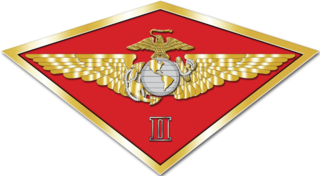
The 2nd Marine Aircraft Wing is the major east coast aviation unit of the United States Marine Corps and is headquartered in Marine Corps Air Station Cherry Point, North Carolina. The Wing provides the aviation combat element for the II Marine Expeditionary Force.
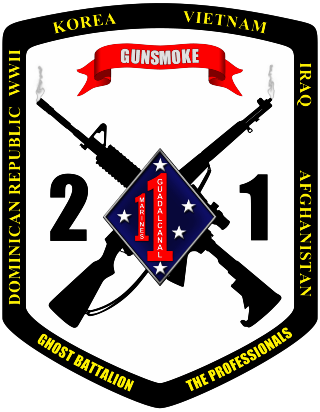
2nd Battalion, 1st Marines (2/1) is an infantry battalion in the United States Marine Corps based in Camp Horno on Marine Corps Base Camp Pendleton, California. Nicknamed "The Professionals," the battalion consists of approximately 1,200 Marines and Sailors. Normally they fall under the command of the 1st Marine Regiment and the 1st Marine Division.
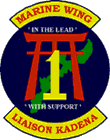
Marine Wing Liaison Kadena (MWLK) is a United States Marine Corps logistics and liaison unit based at Kadena Air Base on Okinawa, Japan. They fall under 1st Marine Aircraft Wing and III Marine Expeditionary Force

The 1995 Okinawa rape incident occurred on September 4, 1995, when three U.S. servicemen, U.S. Navy Seaman Marcus Gill and U.S. Marines Rodrico Harp and Kendrick Ledet, all serving at Camp Hansen on Okinawa, rented a van and kidnapped a 12-year-old Okinawan girl. They beat her, duct-taped her eyes and mouth shut, and bound her hands. Gill and Harp then raped her, while Ledet claimed he only pretended to do so due to fear of Gill. The offenders were tried and convicted in Japanese court by Japanese law, in accordance with the U.S.–Japan Status of Forces Agreement. The families of the defendants initially claimed that Japanese officials had racially discriminated against the men because they were all African American and coerced confessions from them, but later retracted the claims. The incident led to further debate over the continued presence of U.S. forces in Japan among Okinawans.

Earl B. Hailston is a retired Marine Corps lieutenant general. He was Commanding General of United States Marine Corps Forces Pacific, U.S. Marine Forces Central Command, and U.S. Marine Corps Bases Pacific.
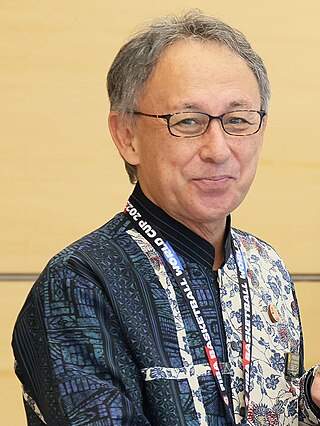
Denny Tamaki is a Japanese politician and the current Governor of Okinawa Prefecture since August 2018.

Over the last five decades there have been various plans for the relocation of Marine Corps Air Station Futenma, a United States Marine Corps base located within the urban area of Ginowan City in Okinawa, Japan.

Naval Base Okinawa, now Naval Facility Okinawa, is a number of bases built after the Battle of Okinawa by United States Navy on the Okinawa Island of Japan. The naval bases were built to support the landings on Okinawa on April 1, 1945, and the troops fighting on Okinawa. The Navy repaired and did expansion of the airfields on Okinawa. United States Navy Seabees built or repaired the facilities on the island. The bases on Okinawa put the United States Armed Forces only 350 miles from Japan's home islands. Most facilities closed after the war, but some are still in use today in all branches of the United States Armed Forces.
References
- ↑ "Marine Corps Bases Japan Home Page". Archived from the original on 2009-03-15. Retrieved 2010-02-15.
- ↑ "Okinawa Marine Feb. 28 Issue". 27 February 2014.